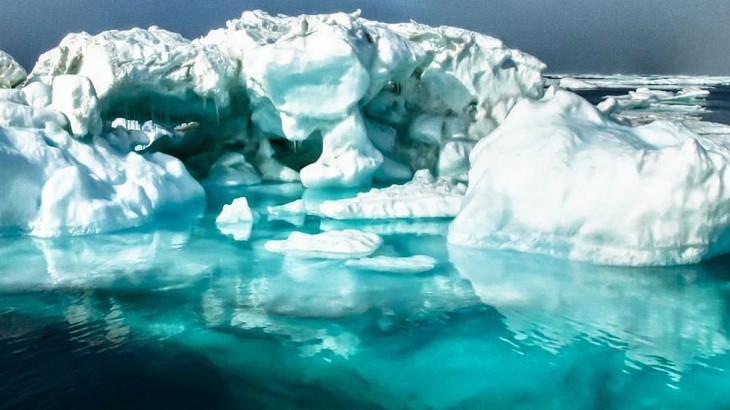Metalworking fluids have a great environmental impact, during all stages of the life cycle. The main environmental effort is therefore to prolong the life of the fluid.
The metalworking fluid's environmental impact start when the oil is pumped of the ground. Here is a quick review of the metalworking fluid's environmental impact, during all steps in the life cycle, from cradle to grave.
Extraction & manufacturing of components
The first step in a metalworking fluid's "life" is production of the ingredients that will be mixed together to produce a metalworking fluid. These can be fossil oils, or synthetically produced alcohols, fatty acids, amines, or other chemicals. Here both the amount and choice of material affects the results that are achieved, but also the energy that is needed to produce different kinds of material. Certain types of production require more energy, and others are perhaps less resource-efficient in total.
At this stage it is primarily the purchaser, the metalworking fluid supplier, which has the opportunity to set requirements for different chemicals. The metalworking fluid supplier also selects itself how the concentrate, which is then mixed with water to produce metalworking fluid, is formulated.
- The chemicals' origin - fossil or vegetable?
- Production of synthetic substances - how effective is the process?
Manufacturing of concentrate
The production of metalworking fluid concentrate has an impact on the environment in several ways. As with all other production factories in the world, much of the production process is powered by electricity, which can have a wide spread of environmental impact depending on energy source. Futhermore, chemical industries use volatile solvents, classified substances and large amounts of water in the production. The sum total of the production process' environmental impact should be reviewed, how much heating or cooling is needed and how effectively the material is utilized - are volatile solvents and expensive metals recycled?
Concentrate producers naturally aim to minimise losses in the production process, as it also entails a cost. Here, the chemists who formulate the concentrate can also have a major responsibility in selection of raw materials. The geographic location of the production planst also has an effect, as the distance and the type of transports affects the final life cycle analysis.
- Electricity consumption in the factory?
- Material efficiency in the factory?
- Emissions of volatile solvents, use of water and heat/cooling?
Transportation
The ingredients of the concentrate, the finished formulation and the used metalworking fluid must all be transported at some point during the life cycle, and thus has a negative impact on the climate and the environment. Important questions to answer are "how", "how far" and "how effective" are the transports. Air transports have a greater impact on the environment than most other kinds of transport. A clear improvement within the area of transport is quite simply to reduce use of the concentrate, since there are then fewer litres that have to be shipped, all the way back to the number of litres of oil from the oil fields.
- How?
- How far?
- How effective?
Use and handling
When the concentrate finally reaches the end user, it has no impact then? No.
When you start using the fluid it naturally has to last for as long as possible, but that also means that large systems are often constructed to maintain the fluid in good condition. How much energy is consumed in pumping, heating/cooling, filtering, purifying and maintaining the metalworking fluid in various ways? How much electricity is consumed per litre of fluid in the system? It may vary between different fluids. Is the service life extended with different kinds of concentrate? There are many questions to answer when it comes to this aspect, which is easy to disregard.
In many cases, the usage phase in a metalworking fluid's life cycle is the one with the largest environmental impact. The consumption may be high of both energy and new concentrate. Fluid changes, large amounts of top-up due to fluid being removed in connection with metal chips, or problems with evaporation mean that the systems consume more concentrate.
- Energy for pumping, filtering and heating/cooling the fluid.
- Energy / litres of fluid in the system? Where does the energy come from, green electricity?
- Losses of metalworking fluid through evaporation, adhering to chips and leakage
Recycling and reuse
Naturally the environmental impact gets lower when the metalworking fluid is reused, since material consumption decreases. You don't need to purchase new fluid.
On the other hand, just as in the previous stage, the entire picture must be described first. How is the fluid recycled, what is required? Which measures are included when reusing, do you need to pump more fluid, filter more fluid, add new concentrate and wash old containers? The choice is sometimes made to evaporate the fluid in order to recover water and reduce the amount of oil and concentrate that has to be transported for final treatment.
- Reduced material consumption
- Reduced costs for destruction
- The entire picture must be taken into consideration, overall it is perhaps not worth recycling fluids with a low environmental impact in other respects
Waste and destruction
When the life cycle is linear, this is the final step in the life cycle. The concentrate is past its best and is sent for destruction in the form of incineration into carbon dioxide and water. In theory, some concentrates should be able to biologically degrade and are thus harmless to aquatic organisms and the environment, and these should not be incinerated. As there unfortunately are almost always harmful and toxic ingredients in the concentrate, in principal they are always incinerated.
In principal, all concentrate must be dealt with as hazardous waste, and must absolutely not be discharged out into drains or watercourses.
- How is the concentrate to be dealt with; incineration, landfill, biological degradation?
- How far away is the recycling plant located?
An environmental friendly solution
Read more about the sustainable and safe way to purify metalworking fluids.



Comment